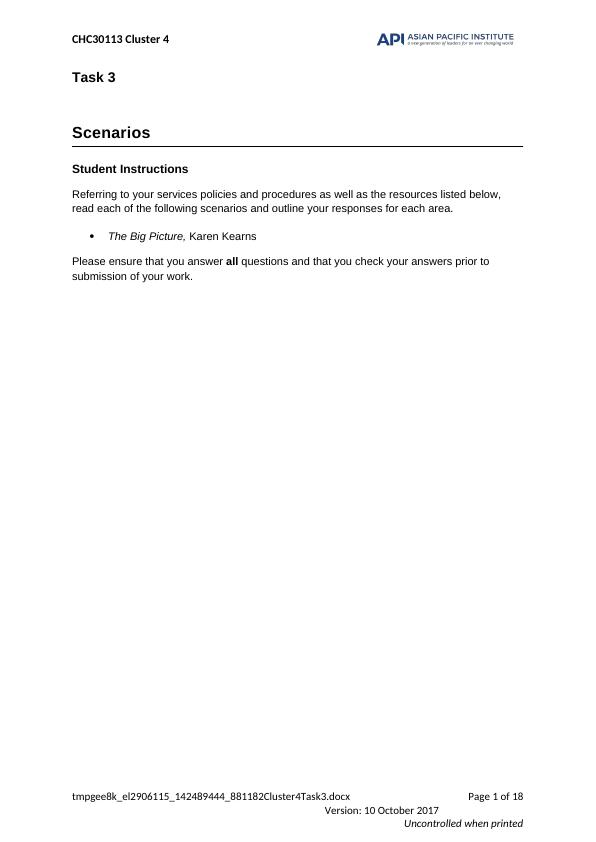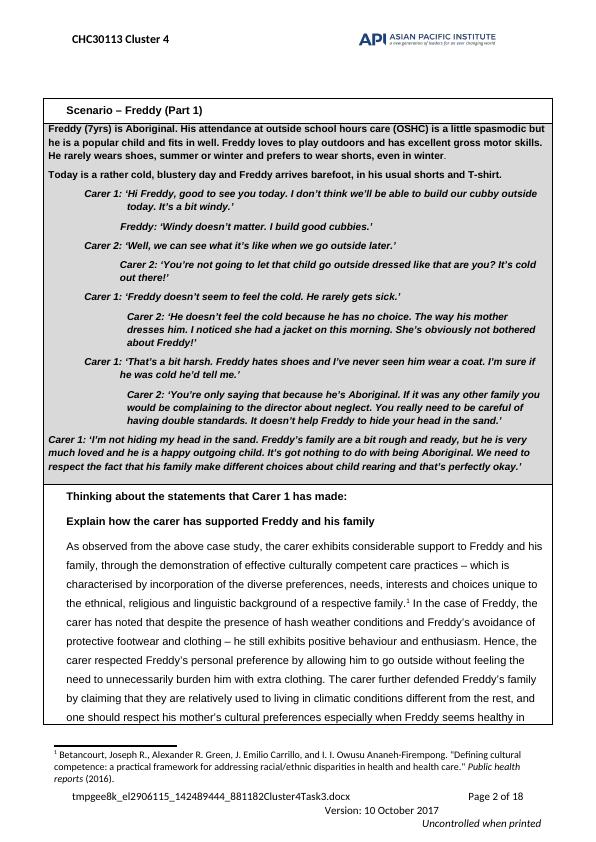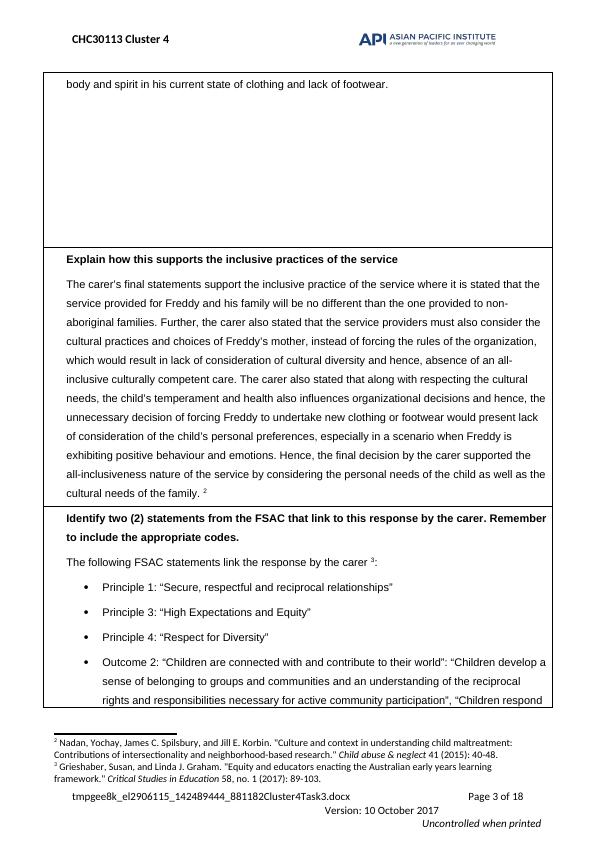CHC30113 Cluster 4 Task 3 Scenarios
Access and collect resources relevant to A&TSI culture, create a resource folder, describe resources for children's service, access a picture/story book about A&TSI culture.
18 Pages5811 Words305 Views
Added on 2023-05-28
About This Document
Read scenarios and outline your responses for each area. Learn how to support children and families in culturally competent care practices. Get strategies to help children understand and address the issue of bias.
CHC30113 Cluster 4 Task 3 Scenarios
Access and collect resources relevant to A&TSI culture, create a resource folder, describe resources for children's service, access a picture/story book about A&TSI culture.
Added on 2023-05-28
ShareRelated Documents
CHC30113 Cluster 4
Task 3
Scenarios
Student Instructions
Referring to your services policies and procedures as well as the resources listed below,
read each of the following scenarios and outline your responses for each area.
The Big Picture, Karen Kearns
Please ensure that you answer all questions and that you check your answers prior to
submission of your work.
tmpgee8k_el2906115_142489444_881182Cluster4Task3.docx Page 1 of 18
Version: 10 October 2017
Uncontrolled when printed
Task 3
Scenarios
Student Instructions
Referring to your services policies and procedures as well as the resources listed below,
read each of the following scenarios and outline your responses for each area.
The Big Picture, Karen Kearns
Please ensure that you answer all questions and that you check your answers prior to
submission of your work.
tmpgee8k_el2906115_142489444_881182Cluster4Task3.docx Page 1 of 18
Version: 10 October 2017
Uncontrolled when printed

CHC30113 Cluster 4
Scenario – Freddy (Part 1)
Freddy (7yrs) is Aboriginal. His attendance at outside school hours care (OSHC) is a little spasmodic but
he is a popular child and fits in well. Freddy loves to play outdoors and has excellent gross motor skills.
He rarely wears shoes, summer or winter and prefers to wear shorts, even in winter.
Today is a rather cold, blustery day and Freddy arrives barefoot, in his usual shorts and T-shirt.
Carer 1: ‘Hi Freddy, good to see you today. I don’t think we’ll be able to build our cubby outside
today. It’s a bit windy.’
Freddy: ‘Windy doesn’t matter. I build good cubbies.’
Carer 2: ‘Well, we can see what it’s like when we go outside later.’
Carer 2: ‘You’re not going to let that child go outside dressed like that are you? It’s cold
out there!’
Carer 1: ‘Freddy doesn’t seem to feel the cold. He rarely gets sick.’
Carer 2: ‘He doesn’t feel the cold because he has no choice. The way his mother
dresses him. I noticed she had a jacket on this morning. She’s obviously not bothered
about Freddy!’
Carer 1: ‘That’s a bit harsh. Freddy hates shoes and I’ve never seen him wear a coat. I’m sure if
he was cold he’d tell me.’
Carer 2: ‘You’re only saying that because he’s Aboriginal. If it was any other family you
would be complaining to the director about neglect. You really need to be careful of
having double standards. It doesn’t help Freddy to hide your head in the sand.’
Carer 1: ‘I’m not hiding my head in the sand. Freddy’s family are a bit rough and ready, but he is very
much loved and he is a happy outgoing child. It’s got nothing to do with being Aboriginal. We need to
respect the fact that his family make different choices about child rearing and that’s perfectly okay.’
Thinking about the statements that Carer 1 has made:
Explain how the carer has supported Freddy and his family
As observed from the above case study, the carer exhibits considerable support to Freddy and his
family, through the demonstration of effective culturally competent care practices – which is
characterised by incorporation of the diverse preferences, needs, interests and choices unique to
the ethnical, religious and linguistic background of a respective family.1 In the case of Freddy, the
carer has noted that despite the presence of hash weather conditions and Freddy’s avoidance of
protective footwear and clothing – he still exhibits positive behaviour and enthusiasm. Hence, the
carer respected Freddy’s personal preference by allowing him to go outside without feeling the
need to unnecessarily burden him with extra clothing. The carer further defended Freddy’s family
by claiming that they are relatively used to living in climatic conditions different from the rest, and
one should respect his mother’s cultural preferences especially when Freddy seems healthy in
1 Betancourt, Joseph R., Alexander R. Green, J. Emilio Carrillo, and I. I. Owusu Ananeh-Firempong. "Defining cultural
competence: a practical framework for addressing racial/ethnic disparities in health and health care." Public health
reports (2016).
tmpgee8k_el2906115_142489444_881182Cluster4Task3.docx Page 2 of 18
Version: 10 October 2017
Uncontrolled when printed
Scenario – Freddy (Part 1)
Freddy (7yrs) is Aboriginal. His attendance at outside school hours care (OSHC) is a little spasmodic but
he is a popular child and fits in well. Freddy loves to play outdoors and has excellent gross motor skills.
He rarely wears shoes, summer or winter and prefers to wear shorts, even in winter.
Today is a rather cold, blustery day and Freddy arrives barefoot, in his usual shorts and T-shirt.
Carer 1: ‘Hi Freddy, good to see you today. I don’t think we’ll be able to build our cubby outside
today. It’s a bit windy.’
Freddy: ‘Windy doesn’t matter. I build good cubbies.’
Carer 2: ‘Well, we can see what it’s like when we go outside later.’
Carer 2: ‘You’re not going to let that child go outside dressed like that are you? It’s cold
out there!’
Carer 1: ‘Freddy doesn’t seem to feel the cold. He rarely gets sick.’
Carer 2: ‘He doesn’t feel the cold because he has no choice. The way his mother
dresses him. I noticed she had a jacket on this morning. She’s obviously not bothered
about Freddy!’
Carer 1: ‘That’s a bit harsh. Freddy hates shoes and I’ve never seen him wear a coat. I’m sure if
he was cold he’d tell me.’
Carer 2: ‘You’re only saying that because he’s Aboriginal. If it was any other family you
would be complaining to the director about neglect. You really need to be careful of
having double standards. It doesn’t help Freddy to hide your head in the sand.’
Carer 1: ‘I’m not hiding my head in the sand. Freddy’s family are a bit rough and ready, but he is very
much loved and he is a happy outgoing child. It’s got nothing to do with being Aboriginal. We need to
respect the fact that his family make different choices about child rearing and that’s perfectly okay.’
Thinking about the statements that Carer 1 has made:
Explain how the carer has supported Freddy and his family
As observed from the above case study, the carer exhibits considerable support to Freddy and his
family, through the demonstration of effective culturally competent care practices – which is
characterised by incorporation of the diverse preferences, needs, interests and choices unique to
the ethnical, religious and linguistic background of a respective family.1 In the case of Freddy, the
carer has noted that despite the presence of hash weather conditions and Freddy’s avoidance of
protective footwear and clothing – he still exhibits positive behaviour and enthusiasm. Hence, the
carer respected Freddy’s personal preference by allowing him to go outside without feeling the
need to unnecessarily burden him with extra clothing. The carer further defended Freddy’s family
by claiming that they are relatively used to living in climatic conditions different from the rest, and
one should respect his mother’s cultural preferences especially when Freddy seems healthy in
1 Betancourt, Joseph R., Alexander R. Green, J. Emilio Carrillo, and I. I. Owusu Ananeh-Firempong. "Defining cultural
competence: a practical framework for addressing racial/ethnic disparities in health and health care." Public health
reports (2016).
tmpgee8k_el2906115_142489444_881182Cluster4Task3.docx Page 2 of 18
Version: 10 October 2017
Uncontrolled when printed

CHC30113 Cluster 4
body and spirit in his current state of clothing and lack of footwear.
Explain how this supports the inclusive practices of the service
The carer’s final statements support the inclusive practice of the service where it is stated that the
service provided for Freddy and his family will be no different than the one provided to non-
aboriginal families. Further, the carer also stated that the service providers must also consider the
cultural practices and choices of Freddy’s mother, instead of forcing the rules of the organization,
which would result in lack of consideration of cultural diversity and hence, absence of an all-
inclusive culturally competent care. The carer also stated that along with respecting the cultural
needs, the child’s temperament and health also influences organizational decisions and hence, the
unnecessary decision of forcing Freddy to undertake new clothing or footwear would present lack
of consideration of the child’s personal preferences, especially in a scenario when Freddy is
exhibiting positive behaviour and emotions. Hence, the final decision by the carer supported the
all-inclusiveness nature of the service by considering the personal needs of the child as well as the
cultural needs of the family. 2
Identify two (2) statements from the FSAC that link to this response by the carer. Remember
to include the appropriate codes.
The following FSAC statements link the response by the carer 3:
Principle 1: “Secure, respectful and reciprocal relationships”
Principle 3: “High Expectations and Equity”
Principle 4: “Respect for Diversity”
Outcome 2: “Children are connected with and contribute to their world”: “Children develop a
sense of belonging to groups and communities and an understanding of the reciprocal
rights and responsibilities necessary for active community participation”, “Children respond
2 Nadan, Yochay, James C. Spilsbury, and Jill E. Korbin. "Culture and context in understanding child maltreatment:
Contributions of intersectionality and neighborhood-based research." Child abuse & neglect 41 (2015): 40-48.
3 Grieshaber, Susan, and Linda J. Graham. "Equity and educators enacting the Australian early years learning
framework." Critical Studies in Education 58, no. 1 (2017): 89-103.
tmpgee8k_el2906115_142489444_881182Cluster4Task3.docx Page 3 of 18
Version: 10 October 2017
Uncontrolled when printed
body and spirit in his current state of clothing and lack of footwear.
Explain how this supports the inclusive practices of the service
The carer’s final statements support the inclusive practice of the service where it is stated that the
service provided for Freddy and his family will be no different than the one provided to non-
aboriginal families. Further, the carer also stated that the service providers must also consider the
cultural practices and choices of Freddy’s mother, instead of forcing the rules of the organization,
which would result in lack of consideration of cultural diversity and hence, absence of an all-
inclusive culturally competent care. The carer also stated that along with respecting the cultural
needs, the child’s temperament and health also influences organizational decisions and hence, the
unnecessary decision of forcing Freddy to undertake new clothing or footwear would present lack
of consideration of the child’s personal preferences, especially in a scenario when Freddy is
exhibiting positive behaviour and emotions. Hence, the final decision by the carer supported the
all-inclusiveness nature of the service by considering the personal needs of the child as well as the
cultural needs of the family. 2
Identify two (2) statements from the FSAC that link to this response by the carer. Remember
to include the appropriate codes.
The following FSAC statements link the response by the carer 3:
Principle 1: “Secure, respectful and reciprocal relationships”
Principle 3: “High Expectations and Equity”
Principle 4: “Respect for Diversity”
Outcome 2: “Children are connected with and contribute to their world”: “Children develop a
sense of belonging to groups and communities and an understanding of the reciprocal
rights and responsibilities necessary for active community participation”, “Children respond
2 Nadan, Yochay, James C. Spilsbury, and Jill E. Korbin. "Culture and context in understanding child maltreatment:
Contributions of intersectionality and neighborhood-based research." Child abuse & neglect 41 (2015): 40-48.
3 Grieshaber, Susan, and Linda J. Graham. "Equity and educators enacting the Australian early years learning
framework." Critical Studies in Education 58, no. 1 (2017): 89-103.
tmpgee8k_el2906115_142489444_881182Cluster4Task3.docx Page 3 of 18
Version: 10 October 2017
Uncontrolled when printed

CHC30113 Cluster 4
to diversity with respect”.
Outcome 3: “Children have a strong sense of wellbeing”: “Children take increasing
responsibility for their own health and physical wellbeing”.
tmpgee8k_el2906115_142489444_881182Cluster4Task3.docx Page 4 of 18
Version: 10 October 2017
Uncontrolled when printed
to diversity with respect”.
Outcome 3: “Children have a strong sense of wellbeing”: “Children take increasing
responsibility for their own health and physical wellbeing”.
tmpgee8k_el2906115_142489444_881182Cluster4Task3.docx Page 4 of 18
Version: 10 October 2017
Uncontrolled when printed

End of preview
Want to access all the pages? Upload your documents or become a member.
